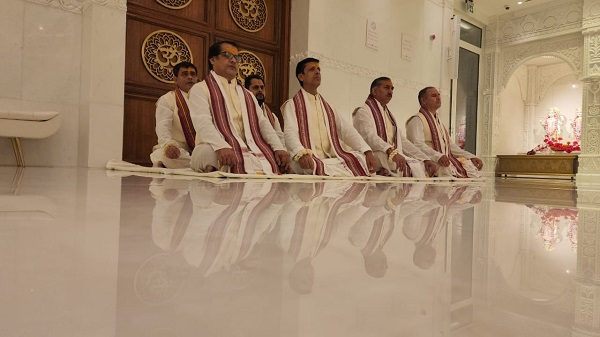Dubai, (Asian independent) The much-anticipated Hindu Temple of Dubai has officially opened its doors in Jebal Ali Worship Village, which houses nine religious shrines, including seven Churches, one Gurudwaras and the new Temple.
Sheikh Nahyan bin Mubarak Al Nahyan, Minister of Tolerance and Coexistence, Sunjay Sudhir, Indian Ambassador to the UAE, Dr. Omar Al-Muthanna, CEO of CDA and Raju Shroff, trustee of the Hindu Temple Dubai, officially welcomed devotees to the 70,000 square foot premises by monumentally lighting a lantern together to celebrate the opening. Over 200 dignitaries, ambassadors and local community leaders attended the celebration.
Burgeoning a new era of tolerance, generosity and inclusivity, the community-run Hindu Temple Dubai is an illuminating structure of devotion and coexistence. It has taken the Hindu Temple Dubai trustees three years to bring this dream to a reality. After one year of planning, as soon as groundbreaking began, Covid had struck the city. Against all odds, with the careful guidance and support of the Dubai government, construction continued over the last two years to bring this landmark to life.
Raju Shroff elaborated in his speech, “Despite Covid-19, construction timelines were not hampered because of the support of the Dubai government. The Hindu Temple Dubai is truly a remarkable icon of how receptive and compassionate the Dubai government is. The Emirati generosity remains. Whether it was in 1958 to launch the first mandir in the country to the Hindu Temple now – we are grateful to be in Dubai.”
The Indian diaspora has played a significant role in the success of the UAE, since they first came to shore in the 1920s. They have been brave pioneers, forging business and cultural ties that bind the social fabric of Dubai since 1958. Back then, community leaders such as Vashu Shroff and his family founded the first Indian Temple, finding its humble beginnings in one room. It was a home that welcomed the diaspora at large to come to find peace when they needed it and at the crossroads of modernity and tradition to ensure the preservation of our beliefs that would be meaningful for the future generation.
Mirroring this expansion, the Indian community saw an astronomical increase in our population from roughly 6000 in 1958 to the 3.3 million people that call it home today. This meteoric rise also breathed new life into every aspect of the economy, from business to tourism making Indians an immensely influential demographic in the region. With over 30,000 businesses ranging from small to medium and even multinational, the community assimilated seamlessly. What we are seeing now is a rich tapestry of interlaced traditions and heritage. Today, Dubai is famously known as India’s best city and making it India’s vital hub.
This impetus led to the birth of The Hindu Temple Dubai, an institution inspired, in part, by the legacy of His Highness Sheikh Mohammed bin Rashid Al Maktoum.
The Temple will aim to mirror his visionary approach by laying the foundation for an establishment that will stand the test of time. A space empowered by a simple but moving thought, ‘For the people, by the people’
The Hindu Temple is a beautiful marriage of two cultures. The showstopping piece is undoubtedly the duality of the traditional Hindu dome atop the Mashrabiya screens infused with the 3D-printed lotus symbol. The transparent dome extends to the sky while the Arabian architecture-inspired screens cast calming shadows through the room.
By incorporating white marble to adorn every inch of the Temple, it beautifies and reflects harmony and purity. The marble pillars and arches are also intricately handcrafted with designs and scriptures. Vastushastra (Hindu architecture) played a crucial role in the eventual decision to create an octagonal shape with an east-facing entrance. The octagonal shape is steeped in Hindu mythology and represents the structure of the sacred Shree Yantra.
The Temple is using digital technology to pre-book visits. By the end of the year, there will be a spacious community center where Hindu ceremonies including rituals and prayers can take place including weddings, naming ceremonies and janiyas (thread ceremony), with an option for catering.
Deities in the temple
Ganapathi – God of beginnings
Lakshmi Narayanan – Goddess of wealth
Lord Guruvayurappan – God of preservation and protection
Lord Ayyappan – God of righteousness and celibacy
Mookambika Devi – Hindu Goddess, who is representing Adi Parashakt and is said to be the mother of the Universe
Balaji – God of justice
Durga Matta – Goddess of protection, strength, motherhood, destruction and wars
Shiv Linga – Shiva Linga is a symbol of lord Shiva: a mark that reminds of the omnipotent lord, which is formless
Radha Krishna – Krishna is the God of protection, compassion, tenderness and love. Radha is his spiritual energy
Jhulelal- Hindu God of water
Ramji Darbar – Coronation of Rama with his wife Sita next to him
Lord Muruga with Valli and Deivanai – God of war and commander of the army of Gods. Deivanai is the Goddess of Kriya Shakti and Valli is the Goddess of Ichha Shakti, meaning the Power of Action and Power of Will respectively, while Lord Muruga represents Gyana Shakti or the power of Wisdom.
Hanumanji- God of wisdom, strength, courage, devotion and self-discipline
Sai Baba – Saint whose teachings concentrate on a moral code of love, charity, forgiveness, contentment, inner peace and devotion to the God and guru
Shri Jalaram Bapa – divine incarnation








